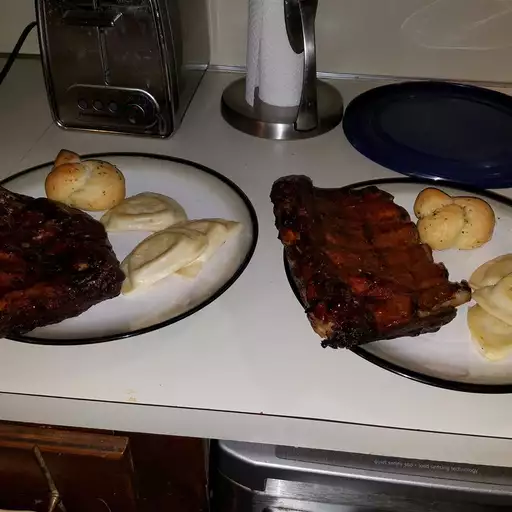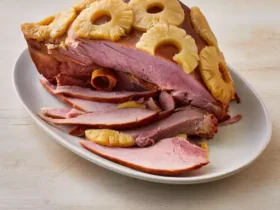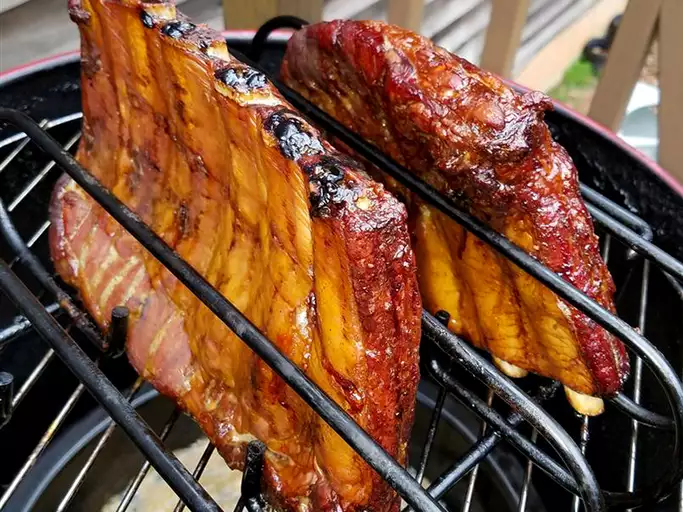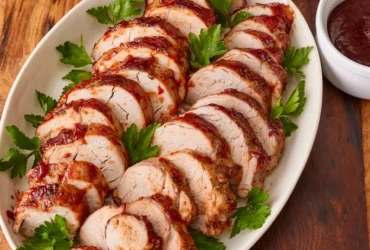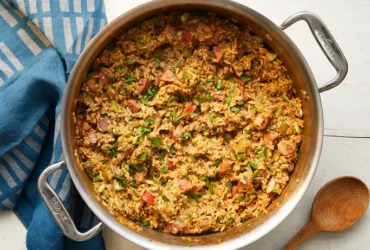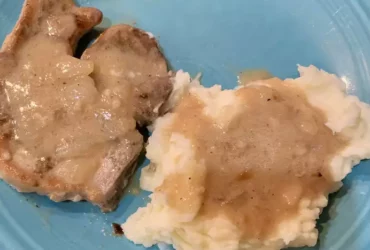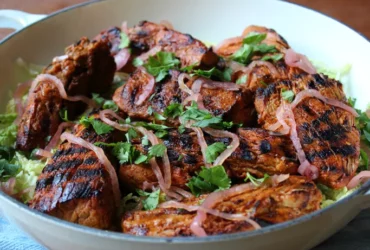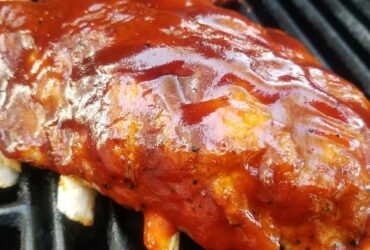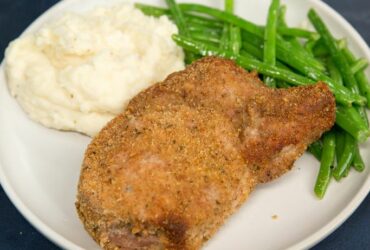Ingredients
Pork ribs
Pork ribs are a staple in many Southern American cuisines, particularly in North and South Carolina where they’re often served at barbecues and family gatherings. The key to achieving tender, fall-off-the-bone pork ribs lies in selecting the right ingredients and following a tried-and-true cooking method.
For this Carolina-Style Ribs recipe, you’ll need the following essential ingredients:
- Pork ribs ( preferably baby back or St. Louis-style pork ribs)
- Sweet barbecue sauce: a mixture of ketchup, brown sugar, vinegar, and spices that adds a tangy, sweet flavor to the ribs
- Pitmaster’s Rub
A pitmaster’s rub is a blend of spices used to season meats before grilling or smoking. For this recipe, you can use a store-bought pitmaster’s rub or create your own custom blend using ingredients like paprika, garlic powder, salt, black pepper, brown sugar, and cayenne pepper.
In addition to these key ingredients, you may also want to have the following on hand:
- Vinegar: a key ingredient in many barbecue sauces that adds a tangy flavor and helps balance out the sweetness
- Mustard: used to thicken the barbecue sauce and add a subtle, slightly sweet flavor
- Pickling spices
Pickling spices are a blend of spices that include ingredients like mustard seeds, coriander seeds, dill seeds, and red pepper flakes. They’re used to add depth and warmth to the barbecue sauce.
The ingredients for this classic Carolina-style ribs recipe are crucial to achieving that tangy, vinegar-based flavor and tender texture. First, we need:
- 4 pounds pork ribs (preferably spare ribs),
- 1/2 cup yellow mustard,
- 1/4 cup white vinegar,
- 2 tablespoons brown sugar,
- 2 teaspoons smoked paprika,
- 1 teaspoon ground black pepper,
- 1 teaspoon salt,
- 1/4 teaspoon cayenne pepper (optional, for some heat),
- 4 cloves garlic, minced,
- 1 tablespoon Worcestershire sauce.
These ingredients are the backbone of this traditional Southern-style ribs recipe. The yellow mustard provides a tangy base, while the white vinegar adds an acidic depth. The brown sugar balances out the flavors with its sweetness. Smoked paprika contributes a rich smokiness, which is quintessential to Carolina-style BBQ.
When choosing the pork ribs, look for spare ribs as they tend to be more tender and easier to handle than baby back ribs or St. Louis-style pork ribs. This recipe doesn’t require any special cuts of meat, so you can stick with your standard grocery store options.
Keep in mind that this recipe relies on the quality of ingredients to produce a truly exceptional flavor profile. Avoid using cheap or low-quality mustard and vinegar as they may impart unpleasant flavors to the final product. For the same reason, choose smoked paprika from a reputable brand for authentic flavor.
Now that you have all the necessary ingredients at your fingertips, it’s time to proceed with the preparation of this delectable Carolina-style ribs recipe!
4 pounds beef or pork ribs
The key to making authentic Carolina-Style Ribs lies in the selection and preparation of the right ingredients. When it comes to ribs, you can choose between beef or pork. For this recipe, we recommend using 4 pounds of either beef or pork ribs, depending on your personal preference.
For beef ribs, look for a cut that has a thick layer of meat and a good amount of cartilage connecting the bones. This will help to keep the meat moist and flavorful during cooking. Beef ribs are typically taken from the chuck or plate section of the cow and are often labeled as “beef short ribs” or “ossobuco.”
Pork ribs, on the other hand, come from the pork belly area and are characterized by their thick layer of fat and meat. You can choose between baby back ribs or spare ribs, both of which will work well for this recipe.
Regardless of whether you’re using beef or pork ribs, it’s essential to look for high-quality meat that is fresh and has a good texture. Avoid choosing ribs with excessive amounts of fat or gristle, as these can make the meat tough and unappetizing during cooking.
When selecting your ribs, consider the cut and shape of the bones. For Carolina-Style Ribs, you want to choose ribs that are relatively straight and have a good amount of meat covering the bone. This will help the ribs hold their shape during cooking and prevent them from becoming too messy or difficult to handle.
Ultimately, the choice between beef and pork ribs comes down to personal preference and what type of flavor profile you’re aiming for. Beef ribs tend to be more robust and savory, while pork ribs are often sweeter and more tender.
2 tablespoons brown sugar
Brown sugar plays a crucial role in many recipes, including barbecue sauces, marinades, and glazes. In the context of the Carolina-Style Ribs Recipe, 2 tablespoons of brown sugar are used to add a rich, caramel-like flavor to the ribs.
Light or dark brown sugar can be used interchangeably in this recipe, but light brown sugar is generally preferred as it has a milder flavor and won’t overpower the other ingredients. The sweetness of the brown sugar helps balance out the tanginess from the vinegar-based sauce and the smokiness from the charcoal grill.
In terms of nutritional value, 2 tablespoons of brown sugar contains approximately 50-60 calories, no fat, and negligible amounts of protein and fiber. Brown sugar is also a good source of carbohydrates, with about 13-15 grams per tablespoon.
When shopping for brown sugar, look for it in the baking aisle or natural foods section of most supermarkets. You can also find it online or at specialty food stores if needed. It’s essential to store brown sugar in an airtight container to maintain its texture and flavor, as exposure to air can cause it to harden.
In addition to its use in the Carolina-Style Ribs Recipe, brown sugar can be used in various other applications such as baking desserts, making sauces, or even as a topping for ice cream. Its versatility makes it a staple ingredient in many kitchens.
1 tablespoon smoked paprika
The ingredient that stands out in this recipe is the one tablespoon of smoked paprika used to add a depth of flavor and a subtle smokiness to the dish.
Smoked paprika, also known as smoked sweet paprika or pimenton, is a type of spice made from ground bell peppers that have been dried and smoked over oak wood fires.
The use of smoked paprika in this recipe gives the Carolina-Style Ribs a distinct flavor profile that is characteristic of traditional Southern American barbecue.
Here are some key characteristics of smoked paprika:
- Flavor Profile: Smoked paprika has a mild, sweet, and smoky flavor with hints of oak wood and earthy undertones.
- Taste: Smoked paprika is often described as having a rich, savory, and slightly bitter taste that complements the sweetness of meats and vegetables.
- Color: Smoked paprika has a deep reddish-brown color due to the smoking process, which also enhances its flavor.
The one tablespoon of smoked paprika in this recipe serves as a concentrated form of smoky flavor that will infuse the ribs with an intense and complex taste experience.
When using smoked paprika, it’s essential to remember that a little goes a long way. The subtle smokiness of smoked paprika can quickly become overpowering if too much is used, so it’s best to start with a small amount and adjust to taste.
In the context of this recipe, the one tablespoon of smoked paprika will likely be combined with other spices, herbs, and seasonings to create a balanced and aromatic blend that perfectly complements the flavors of the pork ribs.
2 teaspoons ground cumin
Cumin is a fundamental spice in many cuisines, particularly in Mexican and Indian cooking. In the context of the Carolina-Style Ribs Recipe, ground cumin serves as an essential component to add depth and warmth to the dish.
The ingredient itself, ground cumin, refers to the seeds of the Cuminum cyminum plant that have been dried, roasted, and then ground into a fine powder. The process of grinding helps to release the aromatic oils contained within the seeds, which are responsible for their distinctive flavor and aroma.
The flavor profile of ground cumin is characterized by its earthy, slightly bitter, and nutty notes, which complement a wide range of ingredients. When used in cooking, ground cumin pairs particularly well with ingredients like chilies, garlic, onion, and cayenne pepper, creating a bold and savory flavor.
In the context of the Carolina-Style Ribs Recipe, two teaspoons of ground cumin is a moderate amount that strikes a balance between enhancing the overall flavor without overpowering it. The use of ground cumin in this recipe contributes to the development of the signature “Carolina-style” flavor profile, which is marked by its smoky, tangy, and slightly spicy characteristics.
The importance of ground cumin in this recipe cannot be overstated, as it serves to bring together various flavors and textures, resulting in a harmonious and delicious outcome. Whether you’re an experienced chef or a novice cook, the inclusion of ground cumin is essential for creating authentic Carolina-style ribs that are sure to impress.
1 teaspoon garlic powder
In the world of culinary delights, ingredients play a crucial role in bringing out the flavor and texture of any dish. When it comes to the delectable Carolina-Style Ribs Recipe, the choice of ingredients is paramount in capturing the essence of this iconic Southern classic.
One of the key ingredients that add depth and richness to the ribs is garlic powder. This versatile spice is a staple in many cuisines, including the bold flavors of the American South. A pinch of garlic powder can elevate the flavor profile of any dish, from savory meats to aromatic vegetables.
The specified amount of 1 teaspoon of garlic powder may seem like a small quantity, but it’s just the right amount to add a subtle yet distinct flavor to the ribs without overpowering them. Garlic powder is a concentrated form of garlic, with the potent flavor and aroma of fresh garlic in a convenient powder form.
When working with garlic powder, it’s essential to remember that a little goes a long way. This means that even a small amount like 1 teaspoon can have a profound impact on the overall taste and aroma of the dish. To get the most out of this ingredient, it’s crucial to use high-quality garlic powder that is fresh and free from additives or fillers.
In the context of the Carolina-Style Ribs Recipe, the 1 teaspoon of garlic powder will complement the sweet and tangy flavors of the ribs, adding a rich and savory depth that will leave your taste buds wanting more. So go ahead, add that pinch of garlic powder to your rub mixture and get ready to indulge in the bold flavors of this Southern classic!
1 teaspoon onion powder
- The ingredients used in traditional Carolina-Style Ribs are carefully selected to achieve a unique flavor profile that complements the slow-cooked pork ribs.
- When it comes to seasoning, onion powder plays a crucial role in adding depth and savory notes to the dish.
- In this context, 1 teaspoon of onion powder is a common measurement used to add just the right amount of flavor without overpowering the other ingredients or the natural taste of the ribs.
- Onion powder is made from dehydrated onions that have been ground into a fine powder, allowing it to easily dissolve and distribute evenly throughout the seasoning blend.
- The subtle sweetness and pungency of onion powder balance out the richness of the pork and enhance the overall flavor experience of the dish.
- When using 1 teaspoon of onion powder in Carolina-Style Ribs Recipe, it’s essential to note that this amount is a standard measurement and can be adjusted to suit individual taste preferences.
- If you’re looking to add more or less onion flavor to your ribs, feel free to experiment with different amounts of onion powder within the seasoning blend.
- The key to achieving that perfect balance of flavors in Carolina-Style Ribs is to use high-quality ingredients and pay attention to the measurements.
Salt and pepper
In the realm of savory flavors, no seasoning duo holds as much sway over culinary enthusiasts as salt and pepper. These two fundamental ingredients play a pivotal role in elevating the depth of flavors in any dish, including the iconic Carolina-style ribs recipe.
Salt, a crystalline mineral derived from underground deposits or harvested through evaporation methods, is an essential component of most recipes. It serves not only as a flavor enhancer but also has preservative properties that help to inhibit bacterial growth and maintain texture. In the context of barbecue, salt is typically used to season meats before cooking, enhancing their natural flavors and acting as a tenderizer.
Pepper, on the other hand, adds a pungent flavor and aroma to dishes. Its spicy kick is attributed to a chemical compound called Piperine, which contributes significantly to the characteristic taste of peppercorns. When used in combination with salt, pepper enhances the overall savoriness of food without overpowering its natural flavors.
When preparing Carolina-style ribs, it’s crucial to strike a balance between these two seasonings to achieve the perfect harmony of flavors. This regional American cuisine emphasizes the use of vinegar, mustard-based sauces, and wood-smoked meats, but it’s in the subtle interplay between salt and pepper where the true essence of these iconic dishes is revealed.
By judiciously combining salt and pepper according to one’s taste preferences, individuals can craft a truly unforgettable dining experience centered around the succulent, tender ribs that epitomize Carolina-style barbecue. This harmonious marriage of flavors not only honors the rich culinary traditions of this regional cuisine but also inspires experimentation and innovation in the pursuit of ultimate gastronomic excellence.
The art of cooking delicious Carolina-style ribs starts with selecting the right ingredients.
To make this mouth-watering dish, you will need to gather a few essential components:
- A rack of pork ribs
- One tablespoon of brown sugar
- One teaspoon of smoked paprika
- One teaspoon of garlic powder
- One teaspoon of onion powder
- One teaspoon of salt
- A half-teaspoon of black pepper
- A quarter-teaspoon of cayenne pepper (optional)
- Two tablespoons of vinegar
- One cup of your favorite barbecue sauce
- Wood chips or chunks for smoking (such as hickory or oak)
- To enhance the flavor of your ribs, you may also want to include some additional ingredients:
- Chopped fresh herbs like parsley, thyme, or rosemary
- A few cloves of garlic, minced
- A tablespoon of olive oil for basting
- A sprinkle of paprika or chili powder on top for added flavor and color
- The key to making great Carolina-style ribs is to balance sweet, tangy, spicy, and smoky flavors. The brown sugar adds a deep sweetness, while the smoked paprika contributes a rich, smoky taste.
- Don’t forget to let your ribs sit at room temperature for about 30 minutes before cooking them. This step will ensure that they cook evenly and quickly.
- Now that you have all the necessary ingredients, it’s time to start cooking! Preheat your smoker or grill to the optimal temperature of around 225-250°F (110-120°C), and get ready to create some finger-licking good ribs!
Preparation
Cooking the ribs
Ribs are a popular barbecue dish that can be cooked to perfection with the right preparation and cooking techniques.
To prepare Carolina-style ribs, you will need the following ingredients:
- 2 pounds pork ribs
- 1/4 cup brown sugar
- 2 tablespoons smoked paprika
- 1 tablespoon garlic powder
- 1 teaspoon salt
- 1/2 teaspoon black pepper
- 1/4 cup vinegar (such as apple cider or white wine)
- 1/4 cup wood chips (such as hickory or oak)
First, preheat your grill to medium-low heat. While the grill is heating up, prepare the ribs by removing the membrane from the back of each rack.
In a small bowl, mix together the brown sugar, smoked paprika, garlic powder, salt, and black pepper to create the dry rub.
Apply the dry rub evenly to both sides of the ribs, making sure to coat them thoroughly. If you’re feeling extra adventurous, you can also add some additional ingredients like diced onions or bell peppers to the dry rub for added flavor.
Once the grill is ready, place the ribs on the grill and close the lid. Cook for 2-3 hours, or until the ribs are tender and falling off the bone.
While the ribs are cooking, prepare the mop sauce by mixing together the vinegar, wood chips, and any additional ingredients you like (such as honey or ketchup).
After the ribs have cooked for 2-3 hours, brush them with the mop sauce every 30 minutes to keep them moist and flavorful.
When the ribs are done, remove them from the grill and let them rest for 10-15 minutes before slicing and serving. You can serve them as is, or top them with additional barbecue sauce if you like.
To prepare for the delightful experience of cooking Carolina-Style Ribs, it’s essential to start with a thorough understanding of the recipe and its requirements.
This involves reviewing the ingredient list, which typically includes pork ribs, barbecue sauce, brown sugar, smoked paprika, garlic powder, salt, black pepper, and any additional spices or seasonings desired.
Next, prepare the ingredients by having all the necessary spices and seasonings measured out in separate bowls to ensure a seamless cooking process.
It’s also crucial to have the necessary tools ready, such as a large baking dish or Dutch oven, a pair of tongs or a meat thermometer, and a sharp knife for trimming excess fat from the ribs.
Before beginning the cooking process, make sure the kitchen is well-ventilated to avoid inhaling any potentially hazardous fumes from the barbecue sauce or spices.
Furthermore, ensure that all utensils and equipment are clean and sanitized to prevent cross-contamination and foodborne illnesses.
Additionally, it’s recommended to plan ahead by preparing a schedule for cooking the ribs, allowing for adequate time for marinating, resting, and cooking each stage of the process.
This will enable you to monitor the temperature and internal meat temperature throughout the cooking process, ensuring that the ribs are cooked to perfection.
Finally, consider having some extra ingredients on hand in case unexpected guests arrive or if a second batch needs to be cooked.
By carefully planning and preparing for each step of the Carolina-Style Ribs Recipe, you’ll set yourself up for success and create an unforgettable dining experience for everyone involved!
Preheat oven to 275°F (135°C)
To prepare for cooking delicious Carolina-Style Ribs, it’s essential to start with proper preparation and preheating of the oven. The first step in preparing the ribs is to remove the membrane from the back of each rack.
This membrane can make the ribs tough and chewy if not removed, so take care to get it off completely before proceeding. To do this, use a paper towel or a damp cloth to grip the membrane firmly, then pull it off in one piece.
Next, pat the ribs dry with paper towels, both on the front and back sides, to remove any excess moisture. This will help the ribs develop a nice crust during cooking.
While the oven is preheating, it’s time to prepare the seasoning blend for the ribs. A classic Carolina-style seasoning mix typically includes paprika, brown sugar, salt, black pepper, cayenne pepper, garlic powder, and onion powder.
Mix these ingredients together in a bowl until they’re well combined. You can adjust the proportions of each spice to suit your personal taste preferences.
Once the oven has reached 275°F (135°C), it’s time to season the ribs generously with the prepared seasoning blend, making sure to coat all surfaces evenly.
Place the seasoned ribs on a baking sheet lined with aluminum foil or parchment paper, leaving some space between each rack to allow for even cooking.
Finally, put the baking sheet with the ribs into the preheated oven and let them cook for 2-1/2 hours, or until they’re tender and fall-off-the-bone delicious.
In a small bowl, mix together brown sugar, smoked paprika, cumin, garlic powder, onion powder, salt and pepper
The key to achieving tender and flavorful Carolina-Style Ribs lies in the thorough preparation of the dry rub, which serves as the foundation for the rich and complex flavors that will develop throughout the cooking process.
To begin, we’ll focus on creating a well-balanced blend that enhances the natural sweetness of the ribs while also introducing subtle smokiness and depth. In a small bowl, mix together the following dry rub ingredients:
Brown sugar: This will provide a hint of caramelized sweetness to balance out the bold flavors.
Smoked paprika: A staple in many BBQ recipes, smoked paprika adds a smoky depth that’s quintessential to the Carolina style.
- Cumin: Ground cumin brings warmth and earthy undertones to the blend, complementing the richness of the ribs.
- Garlic powder: This adds a savory, slightly sweet element that will mellow out as it cooks.
- Onion powder: Similar to garlic powder, onion powder contributes a subtle depth without overpowering the dish.
- Salt and pepper: Essential seasonings that enhance flavor and texture, respectively.
Mix these ingredients together until they form a uniform blend. The consistency should be slightly grainy, as this will ensure an even coating on the ribs during the marinating process. Be sure to adjust the proportions of each ingredient according to your personal taste preferences. Some people may prefer more smoked paprika or a hint less salt; experiment with different ratios to find your ideal balance.
Rub the mixture all over the ribs, making sure they are evenly coated
To prepare the most delicious Carolina-Style Ribs, start by prepping the ribs themselves. Remove any excess fat and membrane from the back of the ribs, then set them aside.
Next, mix together a blend of spices and seasonings to create a rub that will add flavor to your ribs. A classic Carolina-Style Rub typically includes ingredients such as brown sugar, smoked paprika, garlic powder, salt, black pepper, cayenne pepper, and other spices.
In a small bowl, combine the dry ingredients for the rub, making sure to mix them thoroughly. You can also add a pinch of kosher salt or sugar to balance out the flavors.
The key to evenly coating your ribs with the spice blend is to use a generous amount and to spread it around thoroughly. Take the rib rack or individual ribs in one hand, and using a paddle or a spatula, start at one end of the ribs and work your way down, making sure to coat every surface of each rib.
This process is called “rubbing” the mixture onto the meat. You can also use a fork to help you spread the rub evenly, especially on any areas where it might be difficult to get to with a spatula or paddle. Make sure to cover all surfaces, including the underside and between each rib.
As you coat your ribs with the rub, try to use about 1-2 tablespoons per pound of meat. You can also adjust the amount based on how spicy or savory you like it.
Once you have evenly coated all the ribs, make sure they are placed on a baking sheet or in a roasting pan in a single layer with enough room for air to circulate around them. If using individual racks of ribs, place them close together but not touching each other.
Finally, pop that oven-roasted goodness into the oven and let it cook until it reaches your desired level of tenderness!
Place the ribs on a baking sheet lined with aluminum foil, bone side down
- To ensure that your Carolina-style ribs are perfectly prepared, it’s essential to start with a few key steps in preparation. First and foremost, select a rack of pork ribs that has an even thickness of meat across all bones.
- The ideal type of ribs for this recipe is the St. Louis-style pork rib, which typically consists of 13 bones. This cut is prized for its tender and flavorful meat, as well as its robust bark during cooking.
- Next, remove any membrane from the back of the ribs to facilitate even seasoning penetration and promote a better bark formation. You can use a paper towel to help loosen and remove this membrane if needed.
- Rinse the ribs under cold water to remove any excess fat or impurities, and pat them dry with paper towels to prevent sticking during cooking.
- Once you’ve prepared the ribs, it’s time to set up your baking sheet. Line a large rimmed baking sheet with aluminum foil, making sure to cover the entire surface with a single layer of foil.
- This will make cleanup much easier and ensure that the ribs don’t stick to the pan during cooking. You can also use a silicone mat or parchment paper if you prefer a non-stick surface.
- Place the ribs on the prepared baking sheet, bone side down, in a single layer. This allows for even air circulation around the ribs and promotes consistent cooking throughout.
- Making sure to leave space between each rack of ribs is also crucial, as this enables air to circulate underneath and prevents the formation of soggy or undercooked areas on the meat.
Cover the ribs with another sheet of aluminum foil and seal the edges
To prepare for the finishing stages of cooking, it’s crucial to cover the ribs with another sheet of aluminum foil and seal the edges. This step, often referred to as “tenting,” is essential in several ways.
Firstly, tenting helps prevent overcooking by shielding the meat from direct heat. As the ribs continue to cook, the heat will penetrate through the foil, ensuring a uniform level of doneness without burning or charring the exterior.
Secondly, aluminum foil acts as an insulator, maintaining moisture within the ribs and preventing it from escaping. This helps keep the meat tender and juicy, making each bite more enjoyable.
Thirdly, tenting facilitates even cooking by creating a consistent environment around the ribs. By minimizing heat loss through the foil, you ensure that every part of the ribs receives the same amount of heat, resulting in perfectly cooked meat all over.
Lastly, covering the ribs with aluminum foil makes it easier to manage the cooking process. You can handle the ribs without having to worry about them drying out or becoming too crispy due to direct heat exposure.
To ensure a tight seal, use enough foil to cover the entire surface of the ribs and make sure the edges are sealed by folding the excess foil over itself several times. This will prevent steam from escaping and maintain a consistent internal temperature within the ribs.
To prepare for a delicious Carolina-Style Ribs recipe, it’s essential to start with quality ingredients and a solid understanding of the cooking process.
Ingredients
The key to great ribs is using pork ribs that are suitable for slow-cooking and have plenty of connective tissue. Look for St. Louis-style pork ribs or baby back ribs. You’ll also need:
- 1 cup vinegar (white or apple cider work well)
- 1/2 cup water
- 1 tablespoon brown sugar
- 1 teaspoon smoked paprika
- 1 teaspoon salt
- 1/4 teaspoon black pepper
- 2 tablespoons Carolina-style barbecue sauce (or your favorite BBQ sauce)
Preliminary Steps
Before starting the cooking process, take some time to prepare your ribs:
- Rinse the ribs under cold water and pat them dry with paper towels.
- Remove any membrane from the underside of the ribs using a knife or a pair of kitchen shears.
- Trim any excess fat around the edges, if necessary.
Making the Mop Sauce
The mop sauce is a crucial component of Carolina-style ribs. To make it, combine the vinegar, water, brown sugar, smoked paprika, salt, and black pepper in a small bowl until well-mixed.
- Brush the mop sauce evenly over both sides of the ribs.
Cooking the Ribs
The ribs are ready to be cooked. You can use a charcoal grill, gas grill, or even an oven:
- Preheat your grill or oven to 275°F (135°C).
- Cook the ribs for 2-1/2 hours on a charcoal grill or 3 hours in an oven, basting them with mop sauce every 30 minutes.
Finishing Touches
About 10-15 minutes before the ribs are done, brush them with BBQ sauce. This will add a nice glaze to your ribs:
- Remove the ribs from the grill or oven and let them rest for a few minutes.
- Cut the ribs into individual portions, if desired.
Tips for tender ribs
Tenderizing the meat
- To achieve tender ribs, it’s essential to focus on two key aspects: tenderizing the meat and cooking them with a combination of low heat and moisture.
- There are several methods to tenderize ribs, but the most effective one is using an acidic ingredient such as vinegar or buttermilk. This helps break down the proteins and makes the meat more susceptible to moisture absorption.
- Another method for tenderizing ribs is using a meat mallet. Gently pounding the meat with the back of a spoon can help break down the fibers, making it easier for the meat to absorb flavors and become tender.
- Avoid over-tenderizing the meat, as this can lead to mushy or soft texture that’s not desirable in ribs.
Cooking Ribs
- For tender ribs, cook them at a low temperature of around 225-250°F (110-120°C) using a low-and-slow cooking method. This involves placing the ribs on a grill or smoker and cooking them over several hours.
- This process helps break down the connective tissues in the meat, making it tender and fall-off-the-bone. It’s essential to keep an eye on the temperature and ensure that the ribs don’t dry out during the cooking process.
- One key aspect of low-and-slow cooking is using a bark, which refers to the crusty exterior formed on the surface of the ribs as they cook. A good bark can add texture, flavor, and appearance to your Carolina-style ribs.
- To achieve a tender and delicious finish, don’t forget to brush the ribs with a barbecue sauce during the last 10-15 minutes of cooking. This helps add a sweet and tangy flavor that complements the natural taste of the meat.
- Tender ribs are a hallmark of any great barbecue dish, and mastering the art of cooking them requires patience, attention to detail, and a few well-guarded secrets.
- The first step in achieving tender ribs is to choose the right cut of meat. Opt for pork ribs that have a good balance of meat and fat – this will ensure that they stay moist and flavorful throughout the cooking process.
- Before you start cooking your ribs, make sure to remove any membrane from the back of the rib rack. This membrane can prevent the meat from absorbing flavors and can even cause it to become tough and chewy.
- Next, prepare a dry rub by mixing together brown sugar, paprika, garlic powder, onion powder, salt, black pepper, cayenne pepper, and any other spices you like. Rub this mixture all over the ribs, making sure to coat them evenly.
Now it’s time to cook your ribs. There are two primary methods for cooking ribs: dry heat (such as grilling or baking) and wet heat (such as braising or stewing). For Carolina-style ribs, you’ll want to use a combination of both dry and wet heat to achieve that tender, fall-off-the-bone texture.
First, preheat your grill or oven to 275°F (135°C). If using a charcoal grill, make sure to set it up for indirect heat by placing the ribs over a drip pan filled with wood chips (such as hickory or applewood).
Once your grill is hot, place the ribs on the racks and close the lid. Cook for 2-3 hours, or until the meat starts to pull away from the bone.
After the initial cooking time has passed, brush the ribs with a mixture of BBQ sauce, vinegar, and spices (such as brown sugar, smoked paprika, garlic powder, onion powder, salt, black pepper, cayenne pepper). Return the ribs to the grill or oven for another 30 minutes to an hour, or until they’re nicely glazed.
Finally, remove the ribs from the heat and let them rest for at least 10-15 minutes before serving. This will allow the meat to redistribute its juices and become even more tender.
To take your Carolina-style ribs to the next level, consider adding a few finishing touches such as crispy bacon, diced onions, or chopped fresh cilantro.
Use a low oven temperature to cook the ribs, which will help break down the connective tissue and make them tender
To achieve tender and fall-off-the-bone ribs, it’s essential to cook them low and slow. This means setting your oven temperature to around 275°F (135°C) or even lower for a longer cooking time.
The connective tissue in meat, particularly in the collagen found in pork ribs, is what makes it tough. However, when heated slowly over an extended period, this collagen breaks down and turns into gelatin, making the meat tender and juicy.
When cooking low-temperature oven-braised ribs, it’s crucial to have patience and allow enough time for the magic to happen. A good rule of thumb is to cook the ribs for at least 2 1/2 hours or even up to 3 hours if you prefer them extra tender.
To enhance the tenderization process, make sure to wrap your ribs tightly in foil during cooking. This traps steam and creates a humid environment that helps break down the collagen further. You can also add some aromatics like onions, garlic, or herbs inside the foil for added flavor.
Remember, the key to achieving tender ribs is not just about the temperature but also about the duration of cooking time. The slower and longer you cook your ribs, the more tender they’ll become. So, don’t rush the process, and let the low oven do its magic!
It’s worth noting that you can also use a water bath or a slow cooker to achieve similar results. However, for the best flavor and texture, nothing beats cooking low-temperature oven-braised ribs.
Let the ribs rest for 1015 minutes before cutting into them, allowing the juices to redistribute and the meat to relax
The key to achieving tender ribs lies in understanding how they respond to heat, moisture, and patience. One crucial step often overlooked by home cooks is allowing the ribs to rest after cooking.
For Carolina-Style Ribs, resting the ribs for 10-15 minutes is essential before cutting into them. This period of inactivity allows the juices that have been pushed to the surface during cooking to redistribute throughout the meat, resulting in a more even and tender texture.
During this resting time, the collagen within the connective tissues begins to break down further, becoming gelatinous and adding to the overall tenderness of the ribs. This process cannot be rushed, as it requires time for the meat to relax and release its trapped juices.
It’s worth noting that this resting period is not simply a matter of letting the ribs sit; it’s an active process where the meat continues to relax and become more tender with each passing minute. The longer you let them rest, the better they will be, but 10-15 minutes is the minimum recommended time for optimal results.
The patience required to allow your ribs to rest may test your resolve, especially when they’re smelling so good and tempting you to dig in immediately. However, trust that this step is crucial to achieving that perfect tenderness and flavor you’re aiming for.
In summary, resting your ribs after cooking is an essential step in producing tender, fall-off-the-bone ribs. By allowing them to rest for 10-15 minutes, you’ll be rewarded with a delicious dish that’s sure to please even the most discerning palates.
The USDA recommends cooking pork to an internal temperature of at least 145°F (63°C) for food safety
The key to achieving tender and fall-off-the-bone ribs lies in a combination of proper cooking techniques, patience, and attention to temperature. First and foremost, it’s essential to understand that the USDA recommends cooking pork to an internal temperature of at least 145°F (63°C) for food safety.
For Carolina-style ribs, which typically involve slow-cooking over wood or charcoal, a low-and-slow approach is ideal. This means cooking the ribs at a relatively low heat, around 225-250°F (110-120°C), for several hours to allow the connective tissues in the meat to break down and become tender.
To enhance tenderness, it’s crucial to trim any excess fat from the ribs before cooking. This will help the meat cook more evenly and prevent it from becoming greasy or soggy. Additionally, making small slits on the surface of the ribs can aid in even cooking and help the rub penetrate deeper into the meat.
The next step is to apply a dry rub to the ribs, which should include a combination of spices, herbs, and other flavor enhancers such as brown sugar, smoked paprika, garlic powder, or onion powder. The key is to find the right balance between flavors so that nothing overpowers the natural taste of the meat.
Once the dry rub is applied, the ribs are ready for slow-cooking. This can be done using a variety of methods, such as a smoker, a charcoal grill with a lid, or even an oven set to low heat. The important thing is to maintain a consistent temperature and avoid sudden changes in cooking conditions.
During the last hour of cooking, you may choose to brush the ribs with a sweet and tangy barbecue sauce or glaze to add extra flavor. However, this step should be done sparingly, as too much sauce can make the meat sticky and overpowering.
Finally, once the ribs have reached the recommended internal temperature of at least 145°F (63°C), remove them from heat and let them rest for 10-15 minutes before serving. This will allow the juices to redistribute, making the meat even more tender and flavorful.
By following these tips and understanding the importance of proper cooking techniques, you can achieve tender and delicious Carolina-style ribs that are sure to please any crowd.
The key to tender ribs lies in achieving a balance between low and slow cooking methods, allowing the connective tissues in the meat to break down.
The first step is to prepare the ribs for slow cooking, which involves removing the membrane from the underside of the ribcage, known as the pleura. This membrane acts as an insulating layer between the meat and the bone, hindering moisture retention and contributing to tougher texture.
To remove the membrane, simply grab one edge with your fingers or a utensil and gently peel it away from the ribs in smooth, continuous motion. Be careful not to tear any of the surrounding connective tissue as you do so.
Once the membrane is removed, season both sides of the ribs generously using a dry rub composed of salt, black pepper, brown sugar, and your preferred herbs (such as thyme or rosemary). Let the ribs sit at room temperature for about an hour to allow the seasonings to penetrate deeper into the meat.
Next, heat a charcoal grill or smoker to 225°F (110°C) using your choice of wood or charcoal. You can also use a gas grill with wood chips, but be sure to maintain the same low temperature. This is crucial for slow cooking, which helps to tenderize the meat by breaking down the connective tissue.
Once the grill is at the correct temperature, place the ribs directly on the grates or in a foil pan (if using). Close the lid and let them cook undisturbed for 2-3 hours, depending on the size of your ribs. You may also wrap them in foil to prevent overcooking.
Every 30 minutes or so, you can spray the ribs with apple cider vinegar or a similar acidic liquid to enhance browning and add moisture. Use caution not to spray too aggressively as this can cause flare-ups on the grill.
After the initial slow cooking period has elapsed, increase the grill temperature to 300°F (150°C) for an additional 30-60 minutes, or until the ribs are nicely charred on the outside and tender to the bite.
To check doneness, insert a skewer into one of the thicker portions of meat. If it slides in easily with minimal resistance, your ribs should be tender. Otherwise, continue cooking for another 15-30 minutes before rechecking.
- Best Lusha Alternatives for 2025 - April 22, 2025
- Best Overloop Alternatives for 2025 - April 22, 2025
- Best 6sense Alternatives for 2025 - April 22, 2025

